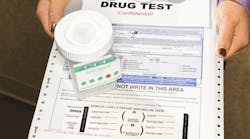A bill that would allow the Department of Transportation to authorize hair testing instead of urinalysis to test drivers for drug use goes against current medical and scientific evidence, according to those familiar with the testing method.
The Drug Free Commercial Truck Driver Act of 2015 "Allows motor carriers to use hair testing as an acceptable alternative to urinalysis for detecting use of controlled substances by an operator, but only for pre-employment testing and random testing (but the latter only if the motor carrier tested the operator at pre-employment using the same method)." The bill, introduced in the House and Senate, enjoys bipartisan co-sponsors, support from the American Trucking Assns. and some fleets.
However, critics of hair testing say that the science doesn't support hair testing, that it's not as accurate as urinalysis and can give incorrect readings for specific groups of people.
When certain drugs are metabolized by the body, they leave chemical markers in hair. These markers can then be found in snipped hair samples and would indicate past drug use. That time lag could be a problem, according to Dr. Kent Peterson, president of Charlottesville, Virginia Occupational Health Strategies and Former Exec. Vice President of American College of Preventive Medicine (ACPM), past President of American College of Occupational and Environmental Medicine (ACOEM), and co-founder and board member of Medical Review Officer Certification Council.
"Hair testing has a window of testing for the previous months or weeks. If you take one and a half inches closest to the scalp it will give an indication of drug use for the past 90 days," he says. "Hair testing may be used for pre-employment screening to show long-term use but it gives no indication of current use or recent impairment."
More important, however, is that hair testing has a bias against some drivers. "Someone with white hair is not depositing any pigments in their hair shaft. I can use any drug I want and I will never test positive for drug use," says Peterson, who as Director of Medical Review Officer education for ACOEM, has trained more than 16,000 physicians and health professionals in workplace drug and alcohol testing. "Curly haired and persons of color are more likely to test positive [because they have more melanin in their hair which binds more strongly with markers]. It's believed that if hair testing were to be used and brought to court, it would be thrown out on that basis alone."
In a case involving six Boston police officers who were fired after testing positive for cocaine, the Massachusetts Civil Service Commission ruled last year that “the present state of hair testing for drugs of abuse... does not meet the standard of reliability necessary to be routinely used” to fire someone…"Hair testing for drugs of abuse has not achieved general acceptance within the scientific or law enforcement communities,” the board wrote.
The Substance Abuse and Mental Health Services Administration (SAMHSA) a branch of the U.S. Department of Health and Human Services, has considered many times whether to recommend hair testing but has not done so because of its shortcomings, says Peterson. A 2013 presentation to SAMSHA's Drug Testing Advisory Board, noted that troubling hair testing issues remain including: not knowing exactly how drugs/metabolites get into hair, concerns about washing and rates of metabolites, environmental or external contamination, hair color bias, interpreting drug use vs. drug exposure, comparison to other tests such as urinalysis, a relatively low sensitivity to marijuana and a high sensitivity to cocaine.
"There are no peer reviewed articles that says hair testing works," says Lewis Maltby, President of the National Workrights Institute in Princeton, New Jersey. Maltby has long argued that many drug testing results are unreliable. "The drug laboratories that do hair testing have been trying to be included in the federal testing program for 20 years and the scientists at NIDA [National Institute on Drug Abuse, part of the National Institutes of Health] say 'no' because they know that hair testing doesn't work… you can find a list of articles about how hair testing works but they're written by people connected to the hair testing companies, and none have appeared in peer-reviewed journals." He adds: "The only people who say hair testing works are those selling hair testing services."
Maltby refutes claims from lab companies that they can adequately wash environmental pollutants from hair in order to produce a clean sample. "There's no dispute that hair can be externally contaminated by walking through a room filled with marijuana smoke... Unlike urinalysis where you're testing for nanograms per milliliter of drug metabolites in a sample, with hair testing you're looking at picograms, which is one, one-thousandth smaller. There's just no way to ensure that the sample is clean."
Why would lawmakers entertain such a bill if the science isn't solid? Maltby concludes: "Congress has been putting pressure on NIDA scientists for years and the scientists won't buckle under… Congress isn't getting buckets of mail from constituents telling them they want hair testing, companies aren't asking for it, no scientists are asking them. It's because people who make big political contributions are asking for it."



